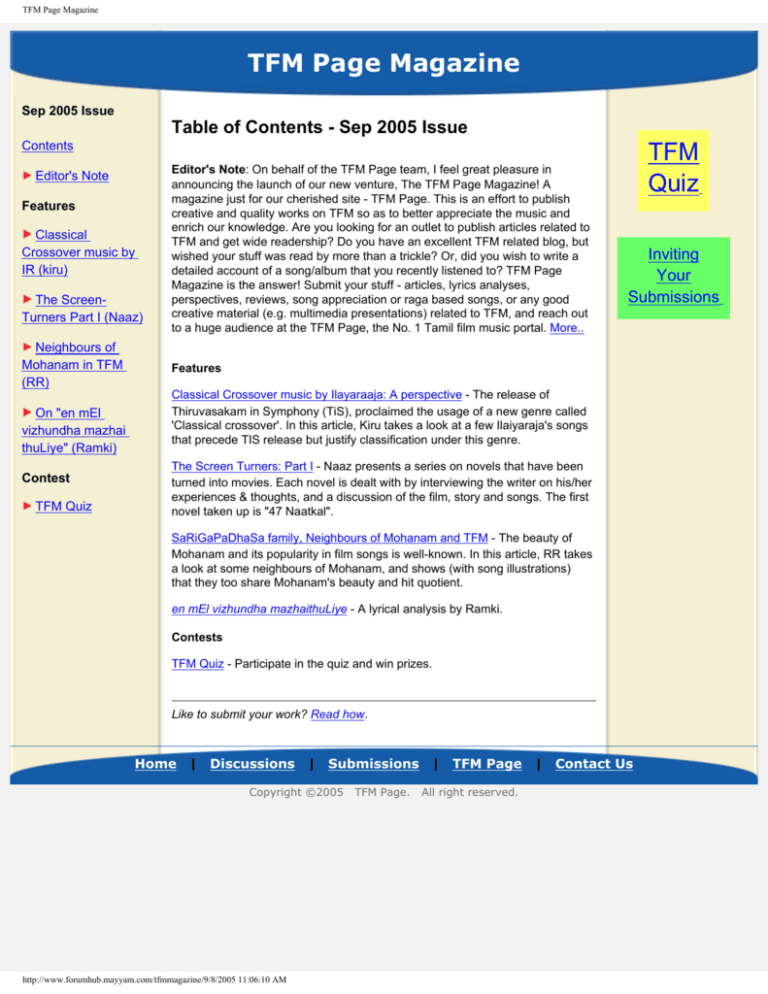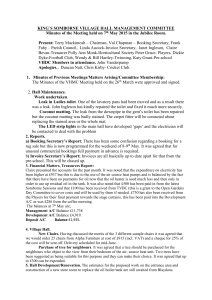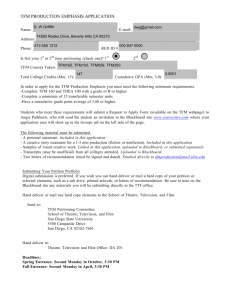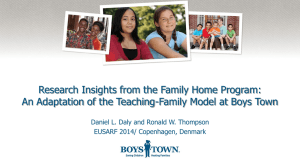
TFM Page Magazine
TFM Page Magazine
Sep 2005 Issue
Table of Contents - Sep 2005 Issue
Contents
Editor's Note
Features
Classical
Crossover music by
IR (kiru)
The ScreenTurners Part I (Naaz)
Neighbours of
Mohanam in TFM
(RR)
On "en mEl
vizhundha mazhai
thuLiye" (Ramki)
Contest
TFM Quiz
Editor's Note: On behalf of the TFM Page team, I feel great pleasure in
announcing the launch of our new venture, The TFM Page Magazine! A
magazine just for our cherished site - TFM Page. This is an effort to publish
creative and quality works on TFM so as to better appreciate the music and
enrich our knowledge. Are you looking for an outlet to publish articles related to
TFM and get wide readership? Do you have an excellent TFM related blog, but
wished your stuff was read by more than a trickle? Or, did you wish to write a
detailed account of a song/album that you recently listened to? TFM Page
Magazine is the answer! Submit your stuff - articles, lyrics analyses,
perspectives, reviews, song appreciation or raga based songs, or any good
creative material (e.g. multimedia presentations) related to TFM, and reach out
to a huge audience at the TFM Page, the No. 1 Tamil film music portal. More..
TFM
Quiz
Inviting
Your
Submissions
Features
Classical Crossover music by Ilayaraaja: A perspective - The release of
Thiruvasakam in Symphony (TiS), proclaimed the usage of a new genre called
'Classical crossover'. In this article, Kiru takes a look at a few Ilaiyaraja's songs
that precede TIS release but justify classification under this genre.
The Screen Turners: Part I - Naaz presents a series on novels that have been
turned into movies. Each novel is dealt with by interviewing the writer on his/her
experiences & thoughts, and a discussion of the film, story and songs. The first
novel taken up is "47 Naatkal".
SaRiGaPaDhaSa family, Neighbours of Mohanam and TFM - The beauty of
Mohanam and its popularity in film songs is well-known. In this article, RR takes
a look at some neighbours of Mohanam, and shows (with song illustrations)
that they too share Mohanam's beauty and hit quotient.
en mEl vizhundha mazhaithuLiye - A lyrical analysis by Ramki.
Contests
TFM Quiz - Participate in the quiz and win prizes.
Like to submit your work? Read how.
Home
|
Discussions
|
Submissions
Copyright ©2005
http://www.forumhub.mayyam.com/tfmmagazine/9/8/2005 11:06:10 AM
TFM Page.
|
TFM Page
All right reserved.
|
Contact Us
TFM Page Magazine
TFM Page Magazine
Sep 2005 Issue
Editor's Note
Contents
TFM
Quiz
Hi TFM-ers,
Editor's Note
Features
Classical
Crossover music by
IR (kiru)
The ScreenTurners Part I (Naaz)
Neighbours of
Mohanam in TFM
(RR)
On "en mEl
vizhundha mazhai
thuLiye" (Ramki)
Contest
TFM Quiz
It's almost an year since we moved to the new TFM DF, and now it's time to try
newer avenues. On behalf of the TFM Page team, I feel great pleasure in
announcing the launch of our new venture, The TFM Page Magazine! A
magazine just for our cherished site - TFM Page. This is an effort to publish
creative and quality works on TFM so as to better appreciate the music and
enrich our knowledge. Are you looking for an outlet to publish articles related to
TFM and get wide readership? Do you have an excellent TFM related blog, but
wished your stuff was read by more than a trickle? Or, did you wish to write a
detailed account about a song/album that you recently listened to? TFM Page
Magazine is the answer! Submit your stuff - articles, lyrics analyses,
perspectives, reviews, song appreciation or raga based songs, or any good
creative material (e.g. multimedia presentations) related to TFM, and reach out
to a huge audience at the TFM Page, the No. 1 Tamil film music portal.
Inviting
Your
Submissions
In case you are wondering how is this different from posting on TFM DF: TFM
Page Magazine is intended to complement the DF. For example, you may have
heard a song/album that has been less appreciated and want to write a detailed
account. Or, you were intrigued by something that you read on the forums and
wished a more in-depth treatment. Or, you might've wished for a medium more
formal than the forums/threads to publish some of your best material. Just
submit them to The TFM Page magazine. We want to make this as the oneand-only magazine on TFM. There are also plans to publish the magazine in
print form (subject to copyright issues). So, many exciting things to come. We
look forward to your support in this new endeavour.
For the debut issue, we have compiled exciting features written by some of the
top DF-ers. There is also a quiz in which you can participate and win prizes. I
hope you'll enjoy it as much as we did putting it together.
Please help promote this effort by passing on the link to your friends, and
related discussion groups/forums/mailing lists.
Thanks,
-RR
(for the Editors' team)
Post comments | Email comments
Like to submit your work? Read how.
Home
|
Discussions
|
Submissions
Copyright ©2005
http://www.forumhub.mayyam.com/tfmmagazine/?t=45879/8/2005 11:07:36 AM
TFM Page.
|
TFM Page
All right reserved.
|
Contact Us
TFM Page Magazine
TFM Page Magazine
Sep 2005 Issue
Contents
Editor's Note
Features
Classical
Crossover music by
IR (kiru)
The ScreenTurners Part I (Naaz)
Neighbours of
Mohanam in TFM
(RR)
On "en mEl
vizhundha mazhai
thuLiye" (Ramki)
Contest
Classical Crossover music by Ilayaraaja: A
perspective
Indian film music was founded on the basis of providing light Indian classical
music with the harmony of western classical music. From the days of G.
Ramanathan one can hear strings-backed songs in Tamil film music. IR
continued this tradition and continued to evolve the usage of strings in a more
complex fashion, especially more contrapuntally. He also later expanded his
repertoire to include all sections of an orchestra, to make the songs more
symphonic. These developments in the music of Ilaiyaraaja, led to the
development of almost a new genre of music, which can be identified by a
strong Western classical personality to them but maintain an Indian raagam/
scale as the base. Since these were being made available to film music
listeners, the songs also had the normal rhythm arrangements commonly found
in popular music. This genre could be called ‘Classical crossover’. Here
classical, refers to western classical music. Indian classical music is usually
accompanied by rhythm instrument (thaala vaadhyam). The polyphonic nature
of western classical music, with many instruments playing, does not require the
use of a rhythm instrument to maintain time. It is only in popular music, that a
rhythm instrument is used. So a ‘classical crossover’ is predominantly western
classical music, accompanied by rhythm instruments. The release of
Thiruvasakam in Symphony (TIS), publicly proclaimed, the usage of this genre
classification, for the first time. In this article, let us look into a list of few songs
which can justify this classification but precede the TIS release.
en kanavinai kEl nanba – dEsiya geetham Listen
TFM Quiz
With a very dynamic range, where the quite first line of the pallavi, with piano
note harmonies, shifts to higher octaves, with the help of the horns and later
strings and the chorus, this song in unmistakably classical in character. The
bass guitar and drums in the charanams give it a popular music appeal. Not to
mention the ‘rapping’ by the children.
dEva sangeetham nee – Guru (Malayalam) Listen
Operatic in character, symphonic in texture this masterpiece from the Guru
(Malayalam) movie would be the choice of a classically minded, film music
listener. It is worthwhile to point out that this movie’s songs were made with the
help of orchestra members from the Hungary Budapest Orchestra. This later
led to the whole album of TIS being produced in Hungary.
chiragattakilli - My dear kuttichaathan Listen
The symphonic opening of this song, does well in adding grandeur to India’s
first 3D movie. The kick drum and the tambourine rhythm make it very
comtemporary sounding, even though the song was done 20 years ago. The
first part of the charanams have string harmony. In the rest of the charanams,
the orchestration plays counterpoint to the main melody.
magaLir mattum - magaLir mattum Listen (last song)
Can a orchestral movie soundtrack be turned into a song? Yes, that is the
thought that would occur to a film music listener when he or she listens to the
pallavi of this song. Ilaiyaraaja pulls of this feat with the help of the chorus in
this song. The interludes starts after a few seconds of silence. This music
director himself has claimed, he uses silence to create music. Decide for
yourself how effective the silence is in this song.
http://www.forumhub.mayyam.com/tfmmagazine/?t=4584 (1 of 3)9/8/2005 11:08:07 AM
TFM
Quiz
Inviting
Your
Submissions
TFM Page Magazine
Enna solli paduvatho – En mana vaanil Listen
A 50 piece string sections gives the drums rhythm backed song a fine classical
touch. The strings sing along with the main singers and sometime play ahead
of them, with the flute filling in. The delays (echo of the singers’ voice) and
harmonium notes add harmony in this song.
Undhan rajyathil - aandaan adimai Listen
This unique song where the pallavi is completely sung by a chorus of children
is impressively backed by the orchestra all through. This is usually not the case
with other film songs. In most of the film songs, the strings are used only for a
part of the song, usually the later part of the charanams. The transitions to the
charanams and the rhythm is typical of a film song (of IR). Contrast, this song
with other songs in the same movie, and the classical nature of this song,
comes out clear.
Idhu thaai pirantha dEsam - siraichaalai Listen
This song starts with a contemporary synth drum beats, a two part vocal
harmony, leads to the pallavi. The unique string phrases lead to the
nationalistic chanting of vandE mataram. The charanams are sung just mainly
with vocal harmonies and a bit of bells. The heavy kettle drums bring in the
chant again. When the pallavi is finally sung with the brass section in full force,
the synth drums are nowhere there to be heard. Has IR converted a lay film
audience to a classical music listener in one song?
Aruna girana – Guru (Malayalam) Listen
Again from the same movie, as dEva sangeetham, this song has a pleasant
woodwind and brass orchestration. The standard drum rhythm gives it a
popular music appeal. The chorus and horns add uniqueness to the song.
Note, the harp notes are played alone. This is one of the basics of writing a
score for an orchestra, the sounds of various would have to be naturally
balanced, with resorting to the mixer to adjust the relative volume of various
instruments.
vandE mataram – bharathi Listen
This song is less classical in structure than the one in dEsiya geetham. The
flowing rhythms, surprisingly not done like a march with snare but with thavil, is
more like popular music, than a rhythm added to more classical composition.
But the complexity and quality of the orchestration gives it a classical flavor
than would any groove-based melody common in film music.
sundari - thalapathy Listen
The prelude of this song starts with the strings playing a standing note on which
is overlaid the flute phrases. There are so many songs in film music with flute
‘fills’ but the ‘flute’ fills in this song have a special appeal. The Mahler like start
of the interlude transitions to a chorus harmony typical of this music director’s
other works. It is only the charanams with the tabla rhythm that makes this
song sound like any other film song. But the audience would have enjoyed the
beauty of a western classical orchestra in this one.
dEsiya geetham - dEsiya geetham Listen
A classic arrangement of brass, strings and a choir lend this song, the
revolutionary feel. Note the use of chorus in the latter part of the charanams. If
only the song had been done with a real orchestra instead of synthesizers, this
would have been an acoustical delight.
thenRal vanthu – avatharam Listen
Multi-part vocal harmony with the traditional tamil music notes (thana thana ..)
http://www.forumhub.mayyam.com/tfmmagazine/?t=4584 (2 of 3)9/8/2005 11:08:07 AM
TFM Page Magazine
gives only a weak indication of what more is to come. This folksy song has
been given a very baroque feel with rich orchestration full of counterpoints. The
charanams are done with string harmony and drum rhythms making it more
easy listening,
The author has tried to bring the predominantly orchestral nature of these
songs. It should also be noted, the composer has resorted to a western
classical approach, only in certain conditions. The song situations have been
either for expressing nationalistic sentiments, different time period or something
very unique.
Though many of these songs were composed for movies in which a western
classical approach was consciously adopted (Guru, dEsiya geetham) many
were done for regular movies in which other songs followed a more standard
approach. It is not very clear whether the audience appreciated these unique
songs or these songs did not get enough exposure because the movies
themselves failed. It is also possible the Indian ear used to listening to
melodies, where the next note or slide is what surprises and fascinates the
mind, is not appreciative of a western classical approach, where many
instruments are playing musical notes in parallel. Maybe some of these songs
had a strong melody and the orchestration was complex in the interludes alone
(eg. sundari from thalapathy), where the melody guaranteed the success of the
song. It probably required a TIS with classic poetry, extreme emotion drenched
devotion and full-fledged orchestration to capture the mind of the Indian
audience. Will a western classical orchestrated album on a secular subject,
with contemporary lyrics be successful with the Indian audience?
-kiru
Post comments | Email comments
Like to submit your work? Read how.
Home
|
Discussions
|
Submissions
Copyright ©2005
http://www.forumhub.mayyam.com/tfmmagazine/?t=4584 (3 of 3)9/8/2005 11:08:07 AM
TFM Page.
|
TFM Page
All right reserved.
|
Contact Us
TFM Page Magazine
TFM Page Magazine
Sep 2005 Issue
Contents
TFM
Quiz
Editor's Note
Features
Classical
Crossover music by
IR (kiru)
The ScreenTurners Part I (Naaz)
Neighbours of
Mohanam in TFM
(RR)
On "en mEl
vizhundha mazhai
thuLiye" (Ramki)
Contest
TFM Quiz
Inviting
Your
Submissions
THE SCREEN-TURNERS
Turn is a special word.
It carries within it a sense of change - be it a manner, a
physical gesture, a trait of character, an everyday phrase, or
even the eternal grave. When someone or something or some
feeling turns, there is a transformation. Mostly, the change is
simple, ordinary, and meaningless. But some times it is
profound. The purpose of this series is to chart that change
with a focus on one commercial turning: What happens when
images of words on the page become images of movement on
the screen? The Screen-Turners will explore this transition of
media – creatively, critically and perhaps, not too
controversially.
There are many books that been made into tamil films. My
selection here is entirely random and evidently contemporary.
In a turn (that word again!) toward selfishness, I have chosen
the books I would like to reread. Some of these are also based
on my music collection – I want to include songs and a close
reading of the lyrics wherever possible – and that really
narrows my choice. To pin this literature, film and music tent,
we might have to head somewhere into the mid-70s, and do
the distance again. The good thing is, most of the books are in
print. And even if you don’t get around to reading them now,
there will be enough here to make you want to look them up
sometime, maybe on a lonely flight from Toronto to Kuala
Lumpur. Trust me, it will bring it all back home.
The format of this exercise is dynamic. Ever changing.
Wherever possible, I will include song files, pictures, interviews,
and such. My analyses of the books turning into films will be all
and only mine. So feel free to rave, rah-rah or ruminate. Here’s
a good one: Literary Access Kollywood! That’s the essence of
the series in a nutshell. Words. Music. Moving Images.And how
http://www.forumhub.mayyam.com/tfmmagazine/?t=4578 (1 of 6)9/8/2005 11:08:32 AM
TFM Page Magazine
they turn around each other.
The Screen-Turners - Interview One.
VISHALI, PARIS, AND BACTERIAL
PROCESSES…
When I called, Sivasankari answered the
phone herself. But that’s the kind of
person she is. I told her about the new
series I was contemplating, and asked her
if she’d have the time to answer a few
questions on 47 Naatkal, the novel and
the film. “I’m busy with a wedding in the
family,” she said, “but I’ll certainly look at
the questions if you send them to me.” I
told her to take her time - and the space
she needed. She got back in a week.
Here’s my Q & A with celebrated author, Sivasankari.
Q. Why 47 Naatkal? Why not 53 or 34 or 69 Naatkal? In other
words, how did you arrive at this span of days? Was the novel
written and ready before it was serialized? Is there any other
reason for this particular choice of number?
A. This is a question asked by many people. In fact, there is no
real reason for selecting 47 days. The novel, as you know, was
written in 1978 and I find it very difficult to recollect how specific
my thinking was! But I can try to tell you why I chose ‘47’ with a
reason. Normally a pregnancy is confirmed after 45 days. Once
Vishali’s pregnancy is confirmed, I wanted to end the story.
Hence, 47 days. And also, I liked the way ‘47 Naatkal’
sounded. It is my practice to write the serial story week after
week, although the entire story would have taken shape within
myself. But, in the case of 47 Naatkal, I remember writing and
completing it in a month’s time before handing it over to Mr.
Manian to be serialised in Idhayam Pesugirathu.
Q: Would it be right to classify 47 Naatkal as a domestic
thriller? Wasn’t this the greatest draw for the audience - the
thriller element of the writing? Or could it be voyeurism?
A: I certainly don’t agree that this novel is planned to be a
domestic thriller. The incidents I heard from some of my close
people led me to write about them. This, added on to my trips
http://www.forumhub.mayyam.com/tfmmagazine/?t=4578 (2 of 6)9/8/2005 11:08:32 AM
TFM Page Magazine
and experiences in the US, consolidated the theme. As far as I
am concerned, writing is a process through which I share the
thoughts that have motivated me into thinking - as authentic
and interesting as possible. I can tell you faithfully that when I
sat to write this novel, there was no intention of making it a
thriller or voyeuristic.
Q: Is Vishali a Victim or Survivor? The novel ends with her
rescue, but what precedes the denouement is a series of
violent acts that can be summed up as spousal abuse. How do
you see her now, given the distance between the novel from
the time of publication and the current strides of Indian
feminism?
A: Vishali was a victim who survived finally. The series of
violence – that erupts out of the inability and anger of Kumar happened very naturally. Kumar behaves like angry caged
animals, whose calculations go haywire and cause his
extraordinary behaviour. Yes, in today’s context, one can
definitely say it is a spousal abuse. But when I wrote the story,
as the events unfolded, whatever naturally would be the
response is what I have tried to depict. You have asked me
how I see her now. To be honest, it will be very difficult. She
can be anything. A successful woman who has learnt her
lessons through bitter experiences, or somebody who is
shattered and finding solace in self-sympathy, or a combination
of both. Everything depends on what kind of mental attitude
she develops after she returns, and the family and social
support she receives.
Q: Is there something more to the character of the ex-pat/NRI
husband? Was the dislocation of Vishali from India to a
western country a cautionary gesture on your part? In other
words, was there a nascent nationalism in the binary of East/
West that the novel seemed to suggest? A division such as,
India = Moral/Traditional, West = Libertarian/Immoral?
A: As I mentioned in one of the earlier answers, in middle 70s I
suddenly happened to hear 2 or 3 incidents in succession
about girls going from here to other countries and finding that
the husband is already married to a foreigner. In those cases
one being educated, returned immediately; one died due to
unknown reasons in France itself; and the third one came out
of it with the help of a German lady. All these made me feel
that I should go in depth with the topic. Because I’d been to
America few times, and the topography and the customs are
familiar, I chose US as the place of action. Otherwise, there is
no particular reason as you mentioned -India-moral/traditional;
west-liberation or immoral. So many such cases happen in
India too. Actually I was invited to Singapore a month ago by
the National Library Committee that comprises of 26 libraries.
http://www.forumhub.mayyam.com/tfmmagazine/?t=4578 (3 of 6)9/8/2005 11:08:32 AM
TFM Page Magazine
They had selected my book ‘47 Naatkal’ for READ Singapore
programme and had invited me for 3 interactions with the
readers. The main reason for their selecting the book is that
they felt the theme is still very contemporary. In fact, in one
meeting a young girl came forward to accept that she was
victimised like Vishali and has come out of the wedlock just a
year ago. I am telling you all these to emphasise that though I
chose US for the base of my novel, this can happen anywhere
and with my inputs is happening everywhere to many people.
Q: What are your views regarding the omniscience of the
Author? How do you negotiate the fine balance between your
own personal views and those of your characters? How
important is authorial control and/or distance to you?
A: Writing is like ‘Parakaya pravesham’ - that is, going from one
body into another. If I project Sivasankari’s views through all
characters, then they will become so alike, boring and there will
be no individuality at all. Hence, I am very clear that the author
cannot penetrate or influence the characters unless there is an
absolute need. Out of 45 or so novels I have written, may be in
two. I have consciously made the main female characters
reflect some of my personal ideas because their
characterisation is somewhat similar to mine.
Q: Of all your works that have been made/adapted for film,
which film was the most faithful to the text?
A: Well, if you are talking about
faithfulness to the text, then it is the recent
film ‘Kutti’. The film has almost ninety-nine
of the text intact. As for 47 Naatkal,
director K. Balachandar told me at the
very first meeting that he doesn’t want
Sivasankari’s readers to blame him that
he has changed the story. Hence, he
wanted me to do the necessary changes.
First, as they were planning to take the
film in Paris, the location had to change.
Then, since most of the scenes in the
book were happening inside the house, they wanted to shift
them to outdoor locations. Also, filming the rescue Vishali
through the Embassy would be difficult, hence they wanted that
to be changed. So I brought in Sarat Babu’s character and
‘Adhisaya Raagam’ song. The adaptation of the movie was
definitely with my consent.
Q: Would I be wrong if I said that 47 Naatkal was a successful
literary work precisely because it was serialized and kept the
reader’s anticipation in high gear every week and throughout,
and which was impossible to create and hold in the film?
http://www.forumhub.mayyam.com/tfmmagazine/?t=4578 (4 of 6)9/8/2005 11:08:32 AM
TFM Page Magazine
A: Every reader has a right to hold on to their view. It is your
opinion that the serialised version of the book was more
successful than the film. People who have not read the book,
seen only the movie, feel it is a very gripping movie.
Q: Did the film lose much of the novel’s communal specificity,
as it was made for two linguistic audiences, tamizh and telugu?
A: I don’t think so. As I mentioned earlier, this kind of incident
has happened, is happening, all over India. I don’t think that it
is restricted to any linguistic state.
Q: If 47 Naatkal were serialized/written today, how would you
change or modify the character of Vishali? To frame it another
way: Would the character’s (under)exposure to the world
around her seem plausible, even realistic?
A: Well, if I decide to create Vishali as an educated girl, then
naturally the sequences would be different. But you must
remember that even today there are lot of illiteracy prevailing in
villages and small towns. Education to women in India is
certainly coming in a big way, but not as fast as we all would
like.
Q: What are the creative compromises in the transfer from one
medium to another book to film?
A: I have explained this in many seminars. If reading belongs to
one medium, the cinema or TV belong to another medium,
though both are creative areas. The former essentially covers
literate groups; and the latter along with literates, also the
illiterate groups. So, it is essential that the text under goes
certain changes - note - I don’t call this compromise.) as it
shifts from one to another medium. What we say in a
paragraph, in a film they can show it in a flash. And, what we
say in one line – “the crowd had thousands of people” would be
very difficult for the visual people. Once we understand these
difficulties, then accepting the changes would be easier. I also
quote one more example in this context. To have excellent
yogurt, it is imperative that the quality of the milk is also good.
Once the milk becomes the yogurt, the entire property
changes. Milk is liquid, sweet; whereas, the yogurt is semi solid
and slightly sour. Instead of commenting about the quality of
yogurt, it would be foolish if one laments that the milk is
spoiled. This is how the adaptation of a novel should be looked
at when it is made into a film.
Songs from 47 Naatkal: Maan kanda sorgangal, thottu kattiya maappillai
http://www.forumhub.mayyam.com/tfmmagazine/?t=4578 (5 of 6)9/8/2005 11:08:32 AM
TFM Page Magazine
Part II - Analysis of 47 Naatkal (Book/Film/Songs) will
appear in next issue.
-Naaz
Author 2005. All rights reserved.
Post comments | Email comments
Like to submit your work? Read how.
Home
|
Discussions
|
Submissions
Copyright ©2005
http://www.forumhub.mayyam.com/tfmmagazine/?t=4578 (6 of 6)9/8/2005 11:08:32 AM
TFM Page.
|
TFM Page
All right reserved.
|
Contact Us
TFM Page Magazine
TFM Page Magazine
Sep 2005 Issue
Contents
SaRiGaPaDhaSa family, Neighbours of Mohanam and
TFM
Editor's Note
Introduction
TFM
Quiz
Features
Classical
Crossover music by
IR (kiru)
The ScreenTurners Part I (Naaz)
Neighbours of
Mohanam in TFM
(RR)
On "en mEl
vizhundha mazhai
thuLiye" (Ramki)
Contest
TFM Quiz
Mohanam means charm, attractiveness, bewitching. Such is the beauty of
this raga. (Actually Mohanam also means beauty!) Hundreds (or is it
thousands?) of film hits in this raga vouch for it. See here for a glimpse.
Not just in India, it's an extremely popular scale in Asian music as well.
Where does all this come from? Just fives swaras Sa Ri Ga Pa Dha, of
which Mohanam is composed of! When I said Sa Ri Ga Pa Dha, were you
reminded of the "Sa Sa Sa Ri Ga, Ri Ri Ri Ga Sa.... Sa Dha Pa" sung by
Latha Rajnikanth in kukuku koo koovum kuyilakka (Valli - Listen)? Yes,
that is Mohanam. Now, a technical fact. Mohanam has 5 swaras and they
are Sa Ri Ga Pa Dha, but having Sa Ri Ga Pa Dha does not imply
Mohanam. *Blink* What does that mean? Before answering that, let's
look at a mapping of the swaras on a keyboard.
Some Theory
====================================
| |##| |##|
| |##| |##| |##|
|
| |##| |##|
| |##| |##| |##|
|
| |R1| |R3|
| |M2| |D1| |D3|
|
| |##| |G2|
| |##| |##| |N2|
|
| |__| |__|
| |__| |__| |__|
|
|
|
|
|
|
|
|
|
| S | R2 | G3 | M1 | P | D2 | N3 |
|
| G1 |
|
|
| N1 |
|
|____|____|____|____|____|____|____|
The figure shows the swara mapping using the standard notation (taking
C as Sadjam). The swaras corresponding to Mohanam are S R2 G3 P
D2. (In western notation, C D E G A.) If you have a keyboard of your own,
you can play these notes and get the lilting feel of Mohanam. Now,
looking at the figure more carefully, we see that there are 3 Ri's (R1 R2
R3), 3 Ga's (G1 G2 G3), 2 Ma's (M1 M2), and so on. And that some of
these overlap. For example, R2 is equivalent to G1, R3 to G2, etc. (Don't
ask me why all this confusion, it's supposed to be convention.). Let's bring
back our key question again: Does having Sa Ri Ga Pa Dha imply
Mohanam? Now, if you have been following me, you'll immediately ask
"Which Ri? Which Ga? which Dha?" Yes, that's right. Depending on
which Ri,Ga or Dha is picked, you may get a new raga. When they are
precisely R2, G3 and D2, we'll get Mohanam. Now, what about the other
combinations? Which ragas these swaras correspond to? Curious, aren't
you? Let's investigate.
SaRiGaPaDhaSa Family
There are 3 each of R,G and D, so the SaRiGaPaDhaSa family
theorectically may have as many as 27 ragas. (Some of them are actually
invalid because of swara overlap, e.g. R2 = G1.) We don't have time for
http://www.forumhub.mayyam.com/tfmmagazine/?t=4573 (1 of 4)9/8/2005 11:08:50 AM
Inviting
Your
Submissions
TFM Page Magazine
all of them. In this article, we'll only look at the nearest neighbours of
Mohanam and tamil film songs on these ragas. By nearest neighbours I
mean ragas that differ from Mohanam in exactly one swara. For example,
S R1 G3 P D2 is an immediate neighbour (only R2 has changed)
whereas S R1 G2 P D2 is not (both R2 G3 have changed). How many
such neighbours are there? We can change R2 -> R1 or R3, G3 -> G1 or
G2, and D2 -> D1 or D3. So, 6 possibilities.
S R1 G3 P D2 (R2 -> R1)
S R3 G3 P D2 (R2 -> R3)
S R2 G1 P D2 (G3 -> G1)
S R2 G2 P D2 (G3 -> G2)
S R2 G3 P D1 (D2 -> D1)
S R2 G3 P D3 (D2 -> D3)
Among these, No. 3 is not a valid member because R2 is same as G1
and hence not a 5 note raga. Also No. 6 by convention should be S R2
G3 P N2 (note that D3 = N2). So, this raga (a rare one, called Veena
Vaadhini) is also out. That leaves 4 ragas.
Neighbours of Mohanam
1. S R1 G3 P D2
This raga is known as Rasika Ranjani. I have not heard a carnatic
composition in this raga but this raga has been a hit in TFM! Ilaiyaraja is
the one who introduced it in Koyil Pura (1981). The song was azhage
thamizhe. Just look at the first line:
azhage thamizhe azhigiya mozhiye enadhuyire
sr g sr g sr gp gr s sr s d.s
He takes a nice sweep along the scale and gives a glimpse of the raga
swaroopa. You may notice that just a touch of R1 is enough to
differentiate it from Mohanam. The tune is simple & sweet. But Ilaiyaraja
reserved the best of Rasika Ranjani till 1984, for an obscure movie
Magudi! The song was the beautiful neelakkuyile unnodu thaan – Listen.
Look at the start again:
gpgrs rssd.s sr gpgr gpgr srg.... gpdpgp S
and also the following brief alap. What a prelude to start off a wonderful
song! I could go on writing more but the purpose here is to give a gilmspe
at the beauty of Mohanam's neighbours, so let's move on to the next.
2. S R2 G2 P D2
This is the hugely popular Sivaranjani. We have tons of songs all over the
Indian film music, including TFM. Curiously almost all decent tunes in this
raga have become hits. Here are a few:
avaravar vaazhkkaiyil (paandavar boomi - Listen). It starts
avaravar vaazhkaiyil aayiram aayiram maattrangal
gg g r s g r s r s d.p.p. d. s s
http://www.forumhub.mayyam.com/tfmmagazine/?t=4573 (2 of 4)9/8/2005 11:08:50 AM
TFM Page Magazine
Good tune. Note how G2 gives a distinctive feel for this raga (compared
to mohanam).
kaathirundhu (vaidegi kaathirunthaal)
kaaththirundhu kaaththirundhu kaalangal ponadhadi
pppppdddpdpgrss
Notice the jump from p to g in "ponadhadi". A standard sivaranjani
signature, that gives a jolt!
There are some pretty good hindi numbers as well. "jaane kahaan
gaye" (mera naam joker) is a cool sivaranjani that just scans the
sivaranjani scale to the upper octave and then down. Yet a lovable tune.
3. S R3 G3 P D2
I don't know the name of this raga, but this is sort of a 'tough' raga
because of the usage of R3 & G3. This is popularly used in TFM with R2.
(So the raga is actually S R2 G2 G3 P D2!) It is called Misra Sivaranjani.
A great example is yezhisai geethame (Rasigan oru rasigai - Listen). Let
us look at the first few lines:
yezhisai geedhame enakoru jeevan neeye
sgr s sd.d. srg sd.r s srgsd. s s
Here it's basically sivaranjani.
vaazhum kaalam yaavum unakkaaga naandhaan
sg rg sd.s sg rg pd srgrs rg g rg3
Now watch carefully the ending at 'naan dhaan'. G3 in touched to give a
beautiful twist. That's Misra sivaranjani! This is further explored in the
next line 'kaaviya veenayil..'.
kudagu malai kaatril oru (karagaattakkaaran) is another example. Listen
specifically to the end of the pallavi "otha vazhi en vazhi thaane..maane".
The usage of R2, G2 & G3 (2 adjacent semitones) gives a pathos feel
that is widely exploited in film songs. An excellent example in Hindi is
"mere naina saawan baadho" (Mehbooba). The line to watch comes in
middle of charanam - "in honThon pe aaye-ey-ey".
Some misra sivaranjani songs also touch D1, but the stress on G3 is the
key.
4. S R2 G3 P D1
This raga is called Vaasandhi (which sometimes allows D2 also). Let's
take kurukku chiruthavale (mudhalvan - Listen) for illustration. The
starting theme gives a brief clue of the raga. Later the female voice enters
with,
oru kaNNil neer kasiya
gg p p p p p d
http://www.forumhub.mayyam.com/tfmmagazine/?t=4573 (3 of 4)9/8/2005 11:08:50 AM
TFM Page Magazine
Do you see something emotive at the end of this line? That's vaasandhi's
D1, which is further explored in
udhattu vazhi usir kasiya
pd p p g gg gr sggrs
adho mega oorvalam (Eramaana rojaave):
adhoa maega oorvalam adhoa minnal thoaranam angae
ss r r g gp gr ss r r g gp gr d p
Notice the vaasanthi feel again at the end. Also at the start of charanam 1:
unadhu paadham adadada ilavam panju
SR S p g gp d p gd p gr s
Summary
In summary, there are four nearest neighbours of Mohanam namely:
Rasika Ranjani, Sivaranjani, Misra Sivaranjani and Vaasandhi, and each
has an intrinsic beauty and lilt. TFM MD's have exploited this to give
many hits in TFM. What is (probably) surprising is: all the neighbours
have a feel that is quite distinct from Mohanam, even though only one
note has been tweaked. Perhaps Mohanam is at such a melodic peak in
the raga space that a slight perturbation throws it up somewhere! Some
other observations are: For all these ragas (including Mohanam), one can
play the notes on a keyboard and still get pretty good feel of the raga.
And, Ilaiyaraja is only one to have composed a song in all the ragas!
-------RR
Post comments | Email comments
Like to submit your work? Read how.
Home
|
Discussions
|
Submissions
Copyright ©2005
http://www.forumhub.mayyam.com/tfmmagazine/?t=4573 (4 of 4)9/8/2005 11:08:50 AM
TFM Page.
|
TFM Page
All right reserved.
|
Contact Us
TFM Page Magazine
TFM Page Magazine
Sep 2005 Issue
Contents
Editor's Note
Features
Classical
Crossover music by
IR (kiru)
The ScreenTurners Part I (Naaz)
Neighbours of
Mohanam in TFM
(RR)
On "en mEl
vizhundha mazhai
thuLiye" (Ramki)
Contest
TFM Quiz
‘en mEl vizhundha mazhaithuLiye" - A Lyrical
Analysis
First love. The situation is beaten to death by our lyricists. Numerous songs
have been written, sung and forgotten. But there are few that will ever live in
our memories. ‘en mel vizhundha mazhaithuLiye’ is one such song. This soft
melodious romantic duet features excellent lines Vairamuthu has ever written in
his carrier.
The very first line captures our attention
‘en mel vizhundha mazhaithuLiye
ithanai naaLai engirundhaai’
I’m sure all of us, at one point of time in
our life, would have wondered where,how
and when an affection, love sprouted out.
It need not have to be romantic love, it
could very well be a friendship that
blossomed suddenly or talent you thought
you never had and there is no poetically
better way to express them.
The poet continues
Indru ezhudhiya en kaviye ithanai naaLai engirundhaai
Ennai ezhuppiya poongaatre ithanai naaLai engirundhaai
Ennai mayakkiya mellisaiye ithanai naaLai engirundhaai
The proclamation progresses with each line. But then apt comes the reply
Udambil uraigindra oaruyir pol unakkuLthaane naan irundhen
Don’t look around you fool. Look within yourself, it’s always been within you,
inside you. Its only today you realized its presence.
The lines are equally philosophical as it is romantic
The charanam explains this concept in detail
Mannai thirandhaal neer irukkum
En manadhai thirandhaal nee iruppai
Oliyai thirandhaal isai irukkum
En uyirai thirandhaal nee iruppai
‘olikuL isai pol ennuL nee’ - Never heard or read this uvamai before. Makes one
to ask
‘indru ezhudhiye Vairamuthe ithanai naaLai engirundheer’?
Vaanam thriandhaal mazhai irukkum
En vayadhai thriandhaal nee iruppai
You will buried in the pages of my history..no I correct that . You will be my
history
Iravai thirandhaal pagal irukkum
En imaiyai thirandhaal nee iruppai
Ilaiyum malarum urasugaiyil
Enne baasahi pesidumo
http://www.forumhub.mayyam.com/tfmmagazine/?t=4447 (1 of 2)9/8/2005 11:09:26 AM
TFM
Quiz
Inviting
Your
Submissions
TFM Page Magazine
Alaiyum karaiyum urasugaiyil
Enne baashai pesidumo
Mannum vinnum urasugaiyil
Enne baashai pesidumo
Paarvai irandum pesikondaal
Baashai oomaiyaividumo
Last few remaining lines are not as outstanding but they aren’t bad either.
Listen to 'en mEl vizhuntha'.
When I first listened to the song I felt like asking
emmai mayakkiye rahmane ithanai naaLai engirundhaai
After listening to few of ARR’s latest albums I feel like asking
emmai mayakkiye rahmane enge tholaindhu poivittai
---Ramki
Post comments | Email comments
Like to submit your work? Read how.
Home
|
Discussions
|
Submissions
Copyright ©2005
http://www.forumhub.mayyam.com/tfmmagazine/?t=4447 (2 of 2)9/8/2005 11:09:26 AM
TFM Page.
|
TFM Page
All right reserved.
|
Contact Us
TFM Page Magazine
TFM Page Magazine
Sep 2005 Issue
TFM Quiz
Contents
TFM
Quiz
1-5. Find Song & movie [50 points]
Editor's Note
* Clues
Features
Classical
Crossover music by
IR (kiru)
The ScreenTurners Part I (Naaz)
Neighbours of
Mohanam in TFM
(RR)
On "en mEl
vizhundha mazhai
thuLiye" (Ramki)
Contest
TFM Quiz
1. "poovin mugavari kaatru ariyume"
2. "avaLai rasitha pinne nilavu innika villai"
3. "Kavignar sonnathu konjam inimel kana povathu manjam"
4. "Selaikalai thirudi andru seitha leelai palakodi"
5. "manavaaLan inge naanamma maharaasan inge naanamma"
Inviting
Your
Submissions
-6. Who wrote "amudhai pozhiyum nilave" (thanga malai ragasiyam)? [10
points]
7. What's the (main) raga of 'sindhu nadhiyin misai nilavinile' (kai kodutha
dheivam)? [10 points]
8. The phunky band "Black eyed Peas" blatantly lifted a tamil film song recently
and remixed it for their latest album. Name the tamil song original & the movie.
[10 point]
9. If you have a favorite song in "Oru Naal Oru Kanavu", "Ah Aah" or "Kanda
Naal Mudhal", write a few lines as to why it's your favorite (Only one song!). [20
points - awarded based on appreciative value as evaluated by the Quiz
master]
--
The winning entry will receive an attractive prize. Pls send your
entiries to this address(tfmmagazine AT forumhub.mayyam.
com) .
You can participate alone or as a team. Discussing the
questions on the forum is not allowed. You'll be disqualified if
you do so. Quiz master's decision is final.
Entries have to reach us by Sep 30, 2005. So, hurry!
Like to submit your work? Read how.
Home
|
Discussions
|
Submissions
Copyright ©2005
http://www.forumhub.mayyam.com/tfmmagazine/?t=45759/8/2005 11:09:36 AM
TFM Page.
|
TFM Page
All right reserved.
|
Contact Us
TFM Page Magazine
TFM Page Magazine
Sep 2005 Issue
Your Submissions
Contents
Editor's Note
Features
Classical
Crossover music by
IR (kiru)
The ScreenTurners Part I (Naaz)
Neighbours of
Mohanam in TFM
(RR)
The TFM Page Magazine is an effort to publish creative and quality works on
TFM so as to better appreciate the music and enrich our knowledge. Are you
looking for an outlet to publish articles related to TFM and get wide readership?
Do you have an excellent TFM related blog, but wished your stuff was read by
more than a trickle? Or, did you wish to write a detailed account about a song/
album that you recently listened to? TFM Page Magazine is the answer! Submit
your stuff - articles, lyrics analyses, perspectives, reviews, song appreciation or
raga based songs, or any good creative material (e.g. multimedia presentations
- we'll assist in realaudio hosting) related to TFM, and reach out to a huge
audience at the TFM Page, the No. 1 Tamil film music portal. Please send your
submissions to this address (tfmmagazine AT forumhub.mayyam.com).
Submissions can be in English or Tamil. If you are sending in tamil, we prefer it
to be in TSCII or UNICODE.
TFM
Quiz
Inviting
Your
Submissions
Please note that all submissions are reviewed and only quality materials will be
accepted for publication. Editor(s)' decision is final.
Terms & Conditions
On "en mEl
vizhundha mazhai
thuLiye" (Ramki)
●
Contest
●
TFM Quiz
●
●
●
You truthfully assert that material being submitted is your own creation
and that you are the lawful copyright holder to this work. Further, you
truthfully assert you have not infringed on anybody else's copyright in
the creation of your submission.
You grant publication rights to this site, while retaining copyrights for
publication on your own in the form of a book, other print media or on
any other websites. Depending upon the topic of your submission and
its approval by the team of our reviewers, it will be published by us on
this site. Topics deemed controversial/offensive topics will NOT be
published.
We are not responsible or liable for loss if visitors to the site violate your
copyright and distribute your creative works without your permission.
There will be no monetary compensation for your submission. (Ours is a
totally non-profit effort.)
You grant us the right to organize, categorize, collate the submitted
materials and present them on the website in any manner we see fit.
Like to submit your work? Read how.
Home
|
Discussions
|
Submissions
Copyright ©2005
http://www.forumhub.mayyam.com/tfmmagazine/index.php?t=45769/8/2005 11:09:50 AM
TFM Page.
|
TFM Page
All right reserved.
|
Contact Us
To those having connection problems
Please use this email
rrprivate-magazine@yahoo.com
for your submissions, contest entries , comments / suggestions /
critiques or any other correspondence.








